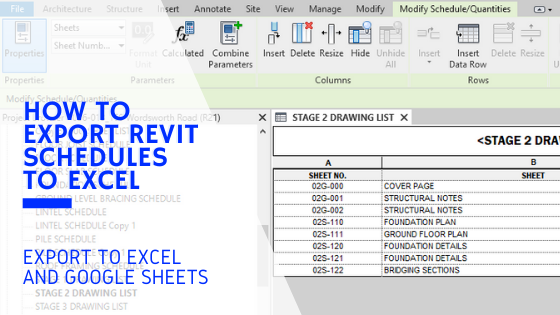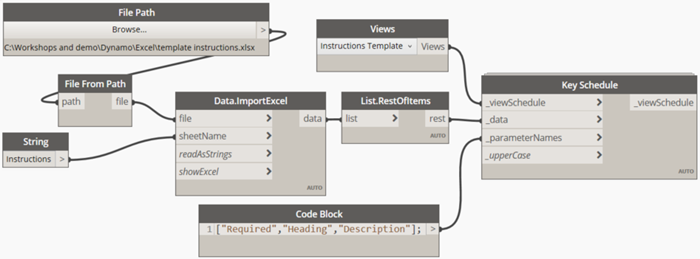Revit Tools: Your Secret to Precision and Efficiency
Wiki Article
Breaking Barriers: Excel Importation Techniques for Advanced Revit Users
Explore various data importation approaches and master Excel combination to boost your Revit modeling capabilities. With our suggestions and tricks, you can get over importation obstacles and end up being a real professional in using Excel for your Revit jobs.Advanced Revit Users: Leveraging Excel for Importation
You can easily take advantage of Excel for importation as an innovative Revit user. Excel is a powerful tool that can greatly improve your operations and efficiency in Revit. With its capability to deal with large quantities of information and carry out intricate calculations, Excel can be an important asset in handling and arranging your project information.One way to take advantage of Excel for importation is by utilizing the "Link Excel" feature in Revit. This feature allows you to link an Excel spreadsheet directly right into your Revit project, allowing you to upgrade and synchronize data between both programs. When dealing with schedules or tracking changes in your job., this can be particularly valuable.
An additional means to use Excel is by making use of the "Import/Export" feature in Revit. This feature enables you to import and export data in between Revit and Excel, providing you the versatility to function with information in both programs. You can import information from Excel into Revit to develop components such as spaces, wall surfaces, or doors, and you can additionally export information from Revit to Excel for further evaluation or reporting.

Exploring Information Importation Approaches in Revit Making Use Of Excel
Checking out how to import data from Excel right into Revit uses efficient techniques for integrating details. When you import information from Excel, you can seamlessly transfer data such as room routines, product listings, and devices information into your Revit project. This process enables you to conserve effort and time by staying clear of hand-operated data entry.To import data from Excel right into Revit, you can utilize the "Import/Export" function. This feature allows you to map the Excel data fields to the corresponding Revit parameters, guaranteeing that the information is appropriately designated within the design. By choosing the suitable import choices, you can control just how the information is imported and just how it communicates with your project.
Another method for importing data from Excel into Revit is by utilizing Dynamo. Dynamo is a visual programs tool that incorporates with Revit and allows you to automate tasks and process. With Dynamo, you can develop personalized manuscripts that import information from Excel and adjust it within your Revit task. This approach offers a lot more versatility and customization choices.
Understanding Excel Combination for Advanced Revit Modeling
One vital technique is importing information from Excel spreadsheets directly right into your Revit design. With a couple of easy steps, you can map the Excel columns to the equivalent Revit criteria and import the data precisely.One more helpful method is exporting data from Revit to Excel. This allows you to remove info from your model, such as routines or product quantities, and evaluate it in Excel utilizing formulas, graphes, or various other powerful devices. By leveraging the capacities of Excel, you can perform intricate calculations, produce personalized reports, and gain useful understandings into your task.
Along with information transfer, Excel integration can automate recurring tasks in Revit. By creating macros or scripts in Excel, you can automate processes like developing sights, creating sheets, or using standard families - revit add ins. This not just conserves time but also guarantees uniformity throughout your project
To master Excel integration in Revit, it is critical to understand the data framework and just how Revit connects with Excel. By acquainting yourself with the available devices and strategies, you can unlock the full potential of Excel assimilation and take your Revit modeling to the following level.
Conquering Importation Obstacles: Excel Techniques for Revit Professionals
When getting rid of importation difficulties, it is necessary to be knowledgeable about reliable Excel methods that can benefit specialists in Revit. As a sophisticated article source Revit user, you understand the value of effortlessly importing information from Excel right into your tasks. Nevertheless, you may come across various challenges along the means. By utilizing effective Excel methods, you can overcome these challenges and visit the site improve your productivity.
An additional useful method is using the "Transpose" function in Excel. This enables you to transform data from rows to columns or the other way around. When importing information into Revit, this can be especially helpful when you have data in an upright layout in Excel, but you need it to be in a straight layout in Revit.
Additionally, using Excel solutions such as VLOOKUP and INDEX-MATCH can significantly help in mapping information from Excel to Revit. These formulas allow you to look for details worths in Excel and recover matching check my site information from an additional column. When importing huge datasets into Revit., this can save you time and effort.
Excel Data Importation Tips and Tricks for Advanced Revit Users
By acquainting on your own with efficient Excel tips and tricks, you can enhance your information importation procedure as a sophisticated user of Revit. Additionally, using Excel's "Paste Special" feature permits you to paste information from Excel into Revit while maintaining format, such as cell shade or font style. Another handy technique is to utilize Excel's "Find and Change" feature to swiftly make modifications to your data prior to importing it into Revit.
Verdict
You have actually now learned valuable strategies for importing data from Excel right into Revit as a sophisticated user. By leveraging the power of Excel integration, you can enhance your modeling process and get over any type of importation challenges that might develop. With these methods and ideas, you will have the ability to master information importation and enhance your Revit abilities. So go ahead, damage those barriers and succeed in your Revit jobs!
When importing information into Revit, this can be especially helpful when you have data in an upright layout in Excel, but you need it to be in a straight layout in Revit.
Additionally, using Excel solutions such as VLOOKUP and INDEX-MATCH can significantly help in mapping information from Excel to Revit. In addition, using Excel's "Paste Special" feature allows you to paste data from Excel right into Revit while keeping format, such as cell color or font style.
Report this wiki page